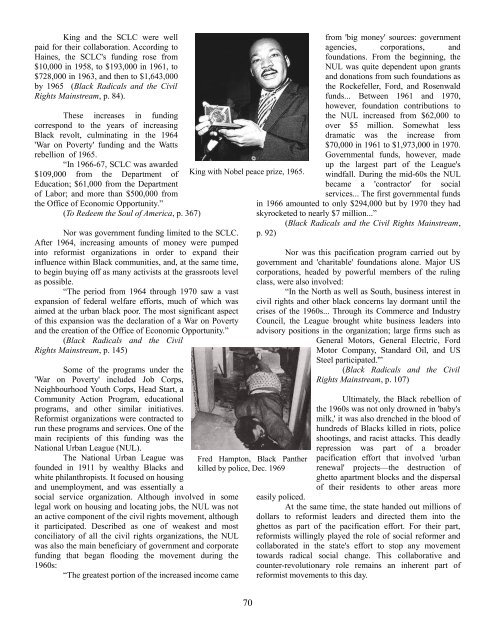smash-pacifism-zine
smash-pacifism-zine
smash-pacifism-zine
You also want an ePaper? Increase the reach of your titles
YUMPU automatically turns print PDFs into web optimized ePapers that Google loves.
King and the SCLC were well<br />
paid for their collaboration. According to<br />
Haines, the SCLC's funding rose from<br />
$10,000 in 1958, to $193,000 in 1961, to<br />
$728,000 in 1963, and then to $1,643,000<br />
by 1965 (Black Radicals and the Civil<br />
Rights Mainstream, p. 84).<br />
These increases in funding<br />
correspond to the years of increasing<br />
Black revolt, culminating in the 1964<br />
'War on Poverty' funding and the Watts<br />
rebellion of 1965.<br />
“In 1966-67, SCLC was awarded<br />
$109,000 from the Department of<br />
Education; $61,000 from the Department<br />
of Labor; and more than $500,000 from<br />
the Office of Economic Opportunity.”<br />
(To Redeem the Soul of America, p. 367)<br />
Nor was government funding limited to the SCLC.<br />
After 1964, increasing amounts of money were pumped<br />
into reformist organizations in order to expand their<br />
influence within Black communities, and, at the same time,<br />
to begin buying off as many activists at the grassroots level<br />
as possible.<br />
“The period from 1964 through 1970 saw a vast<br />
expansion of federal welfare efforts, much of which was<br />
aimed at the urban black poor. The most significant aspect<br />
of this expansion was the declaration of a War on Poverty<br />
and the creation of the Office of Economic Opportunity.”<br />
(Black Radicals and the Civil<br />
Rights Mainstream, p. 145)<br />
Some of the programs under the<br />
'War on Poverty' included Job Corps,<br />
Neighbourhood Youth Corps, Head Start, a<br />
Community Action Program, educational<br />
programs, and other similar initiatives.<br />
Reformist organizations were contracted to<br />
run these programs and services. One of the<br />
main recipients of this funding was the<br />
National Urban League (NUL).<br />
The National Urban League was<br />
founded in 1911 by wealthy Blacks and<br />
white philanthropists. It focused on housing<br />
and unemployment, and was essentially a<br />
social service organization. Although involved in some<br />
legal work on housing and locating jobs, the NUL was not<br />
an active component of the civil rights movement, although<br />
it participated. Described as one of weakest and most<br />
conciliatory of all the civil rights organizations, the NUL<br />
was also the main beneficiary of government and corporate<br />
funding that began flooding the movement during the<br />
1960s:<br />
“The greatest portion of the increased income came<br />
King with Nobel peace prize, 1965.<br />
Fred Hampton, Black Panther<br />
killed by police, Dec. 1969<br />
from 'big money' sources: government<br />
agencies, corporations, and<br />
foundations. From the beginning, the<br />
NUL was quite dependent upon grants<br />
and donations from such foundations as<br />
the Rockefeller, Ford, and Rosenwald<br />
funds... Between 1961 and 1970,<br />
however, foundation contributions to<br />
the NUL increased from $62,000 to<br />
over $5 million. Somewhat less<br />
dramatic was the increase from<br />
$70,000 in 1961 to $1,973,000 in 1970.<br />
Governmental funds, however, made<br />
up the largest part of the League's<br />
windfall. During the mid-60s the NUL<br />
became a 'contractor' for social<br />
services... The first governmental funds<br />
in 1966 amounted to only $294,000 but by 1970 they had<br />
skyrocketed to nearly $7 million...”<br />
(Black Radicals and the Civil Rights Mainstream,<br />
p. 92)<br />
Nor was this pacification program carried out by<br />
government and 'charitable' foundations alone. Major US<br />
corporations, headed by powerful members of the ruling<br />
class, were also involved:<br />
“In the North as well as South, business interest in<br />
civil rights and other black concerns lay dormant until the<br />
crises of the 1960s... Through its Commerce and Industry<br />
Council, the League brought white business leaders into<br />
advisory positions in the organization; large firms such as<br />
General Motors, General Electric, Ford<br />
Motor Company, Standard Oil, and US<br />
Steel participated.'”<br />
(Black Radicals and the Civil<br />
Rights Mainstream, p. 107)<br />
Ultimately, the Black rebellion of<br />
the 1960s was not only drowned in 'baby's<br />
milk,' it was also drenched in the blood of<br />
hundreds of Blacks killed in riots, police<br />
shootings, and racist attacks. This deadly<br />
repression was part of a broader<br />
pacification effort that involved 'urban<br />
renewal' projects—the destruction of<br />
ghetto apartment blocks and the dispersal<br />
of their residents to other areas more<br />
easily policed.<br />
At the same time, the state handed out millions of<br />
dollars to reformist leaders and directed them into the<br />
ghettos as part of the pacification effort. For their part,<br />
reformists willingly played the role of social reformer and<br />
collaborated in the state's effort to stop any movement<br />
towards radical social change. This collaborative and<br />
counter-revolutionary role remains an inherent part of<br />
reformist movements to this day.<br />
70



